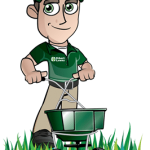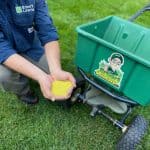Summer heat is hard on all of us, especially on lawns. When temperatures rise the majority of us can hide out from the heat indoors with air conditioning. Lawns do not have this luxury; instead it has the sun’s rays beating down on them day in and day out. These conditions can cause heat and drought stress to the lawn.
How do you identify heat and drought stress?
The first and easiest method in identifying drought stress is giving your lawn a thorough look. A stressed lawn typically has brown patchy areas throughout the lawn. It may not be immediately evident when looking at the lawn that there is a problem. If you suspect your lawn is suffering from drought stress, there are some tests you or a lawn care technician can do.
-
Crunch test – To perform this test you will need to take a stroll around your lawn. If you can hear a distinct “crunch” as you take each step this can signify drought stress. In times of stress like this your lawn will not be able to keep the blades hydrated. They tend to crisp up and become crunchy. Take this test a step further and look behind you. If you see footprints in the grass, where you have walked, this can be another indicator. Especially if you aren’t 100% sure you’ve heard a crunch.
-
Pull test – While under stress the root system of your lawn can suffer even if it isn’t apparent from looking at the blades. To perform this test grab a blade of grass and give it a tug. Roots should be thick and deep to have a healthy lawn. If you pull up thin shallow roots during a hot summer day then it is likely your lawn is suffering and is susceptible to the full effects of drought stress. When roots are shallow they lose an opportunity to soak up the water they need since the hot sun will evaporate most water that is near the surface of the soil.
-
Screwdriver test – If you were able to identify brown or crunchy patches in your lawn then this is a great way to indicate how the soil is reacting to the hot sun. First do a control test on a part of your lawn that looks healthy and green. Poke the screwdriver in and it should go in and come out again smoothly. Next move on to the area in question and do the same. If it is harder to get the screwdriver into the soil this time your soil may be compacted and is preventing water from penetrating the roots.
You now should be able to identify if your lawn is experiencing drought stress. Can it be fixed? Good news is that just because a lawn is struggling from the heat does not mean it is a lost cause. Increasing your watering is a great start but there is something else you can do.
Erbert Lawns offers a lawn treatment called Revive to all customers who are part of our Weed Wipe-Out and Fertilization program. Even the healthiest lawns can benefit from Revive because the summer sun can be unpredictable. Typically in the summer the soil temperatures are at their peak and retaining water becomes increasingly difficult. Revive is a wetting agent that is designed to aid your lawn in getting the most out of the water you put on it. Revive will allow water to penetrate more deeply into the soil which will in turn promote root growth. Root health ultimately equals lawn health. Another perk of Revive is that it will save you money on your water bill because less water will be evaporated off into the atmosphere.
Call Erbert Lawns today to set up a lawn care program to have experts just a phone call away for all of your lawn care needs.











